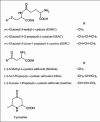Quantification of allicin by high performance liquid chromatography-ultraviolet analysis with effect of post-ultrasonic sound and microwave radiation on fresh garlic cloves
- PMID: 24991105
- PMCID: PMC4078350
- DOI: 10.4103/0973-1296.133279
Quantification of allicin by high performance liquid chromatography-ultraviolet analysis with effect of post-ultrasonic sound and microwave radiation on fresh garlic cloves
Abstract
Background: Garlic (Allium sativum L.) has been accepted universally to be applied in food, spice and traditional medicine. The medicinal and other beneficial properties of garlic are attributed to organosulfur compounds.
Objective: As of today no simultaneous analysis has been performed; hence the transformation of allicin to its degraded products during cultivation and storage is open into doubt.
Materials and methods: In our present work, we have tried to develop a sensitive and reproducible analytical method to measure allicin by high performance liquid chromatography-ultraviolet analysis with effect of post-acoustic waves and microwave radiation on fresh garlic cloves.
Results: The process revealed the effect of different radiation techniques on fresh garlic retains the principle component, allicin in its pure form and generated higher yield than the conventional way of extraction.
Conclusion: Therefore, materializing these techniques in the pharmaceutical industry will definitely be proved beneficial in term of time as well as money. Most interestingly, the methods ruled out possibilities of degradation of organosulfur compounds as well.
Keywords: Acoustic waves; allicin; garlic; high performance liquid chromatography-ultraviolet analysis; microwave radiation.
Conflict of interest statement
Figures










Similar articles
-
Influence of pH, concentration and light on stability of allicin in garlic (Allium sativum L.) aqueous extract as measured by UPLC.J Sci Food Agric. 2015 Jul;95(9):1838-44. doi: 10.1002/jsfa.6884. Epub 2014 Sep 25. J Sci Food Agric. 2015. PMID: 25205359
-
Novel strategies for optimized delivery of select components of Allium sativum.Pharmacognosy Res. 2014 Oct;6(4):334-40. doi: 10.4103/0974-8490.138288. Pharmacognosy Res. 2014. PMID: 25276072 Free PMC article.
-
Quantitative determination of allicin in garlic: supercritical fluid extraction and standard addition of alliin.J Agric Food Chem. 2004 Feb 25;52(4):682-7. doi: 10.1021/jf034853x. J Agric Food Chem. 2004. PMID: 14969516
-
Therapeutic uses and pharmacological properties of garlic, shallot, and their biologically active compounds.Iran J Basic Med Sci. 2013 Oct;16(10):1031-48. Iran J Basic Med Sci. 2013. PMID: 24379960 Free PMC article. Review.
-
Chemical composition and bioactive compounds of garlic (Allium sativum L.) as affected by pre- and post-harvest conditions: A review.Food Chem. 2016 Nov 15;211:41-50. doi: 10.1016/j.foodchem.2016.05.029. Epub 2016 May 6. Food Chem. 2016. PMID: 27283605 Review.
Cited by
-
Insights into garlic (Allium Sativum)'s nutrigenomics-associated fly-repellent potency in cattle.Trop Anim Health Prod. 2025 Apr 3;57(3):154. doi: 10.1007/s11250-025-04406-7. Trop Anim Health Prod. 2025. PMID: 40178647 Free PMC article. Review.
-
Prevailing Knowledge on the Bioavailability and Biological Activities of Sulphur Compounds from Alliums: A Potential Drug Candidate.Molecules. 2020 Sep 9;25(18):4111. doi: 10.3390/molecules25184111. Molecules. 2020. PMID: 32916777 Free PMC article. Review.
-
Retention of Bioactive Compounds During Domestic Processing of Croatian Domestic Garlic (Allium sativum L.).Food Technol Biotechnol. 2018 Dec;56(4):590-596. doi: 10.17113/ftb.56.04.18.5709. Food Technol Biotechnol. 2018. PMID: 30923456 Free PMC article.
-
Anti-biofilm efficacy of a medieval treatment for bacterial infection requires the combination of multiple ingredients.Sci Rep. 2020 Jul 28;10(1):12687. doi: 10.1038/s41598-020-69273-8. Sci Rep. 2020. PMID: 32724094 Free PMC article.
-
Dietary organosulfur compounds: Emerging players in the regulation of bone homeostasis by plant-derived molecules.Front Endocrinol (Lausanne). 2022 Sep 15;13:937956. doi: 10.3389/fendo.2022.937956. eCollection 2022. Front Endocrinol (Lausanne). 2022. PMID: 36187121 Free PMC article. Review.
References
-
- Young NJ, Yong-Hoon C, Chul-Hak Y. Identification of an essential tryptophan residue in alliinase from garlic (Allium sativum) by chemical modification. Bull Korean Chem Soc. 2001;22:68–76.
-
- Hans-Peter K. Dissertation zur Erlangung des Doktorgrades der Fakultät für Chemie und Pharmazie der Ludwig-Maximilians-Universität München; 2003. Interaction of Allium sativum L. and Leontopodium alpinum cass. with mediators of inflammation involved in the molecular mechanisms of atherosclerosis.
-
- Mukherjee M, Das AS, Das D, Mukherjee S, Mitra S, Mitra C. Role of oil extract of garlic (Allium sativum Linn.). on intestinal transference of calcium and its possible correlation with preservation of skeletal health in an ovariectomized rat model of osteoporosis. Phytother Res. 2006;20:408–15. - PubMed
-
- Raghuveer C. Benificial effect of Allium sativum and Allium tuberosum on experimental hyperlipidemia and atherosclerosis. Pak J Physiol. 2008;4:7–9.
-
- Dkhil MA, Abdel-Baki AS, Wunderlich F, Sies H, Al-Quraishy S. Anticoccidial and antiinflammatory activity of garlic in murine Eimeria papillata infections. Vet Parasitol. 2011;175:66–72. - PubMed
LinkOut - more resources
Full Text Sources
Other Literature Sources
Research Materials
